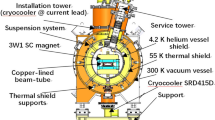Abstract
Introduction
The superconducting wiggler magnet named as 3W1 is the key device for the test facility for the High Energy Photon Source (HEPS). The magnet structure is 1430 mm long with a gap of 68 mm, and the designed peak field is 2.6 T. The main magnet part is comprised by 28 main coils and 4 correction coils at both ends. Due to the large gap and high field, the manufacturing process is extremely difficult.
Method
During R&D, the problems of coil winding, impregnation, pre-stress evaluation and quench risk control were solved by optimizing the technology. The coils were divided into groups to complete the cryogenic test, and the qualified coils were selected to complete the assembly of the magnet.
Conclusion
The bare magnet has been tested with liquid helium bath in April 2018 in IHEP, and the loading current reached up to 345 A resulting in the expected 2.61 T. In this paper, the technology about the coil winding, impregnation, assembling and test is presented in detail.













Similar content being viewed by others
References
K. Zhang, Q. Xu, Z. Zhu et al., 2-D mechanical design study of a 20-T two-in-one common-coil dipole magnet for high-energy accelerators. IEEE Trans. Appl. Supercond. 26, 4 (2016)
X. Yang, Q. Peng, D. Cheng, et al, The superconducting magnet for ADS injection-I. Radiat. Detect. Technol. Methods (2018)
M. Xu, R. Ge, L. Bian et al., Design and research of cryostat for 3W1 superconducting wiggler magnet. IEEE Trans. Appl. Superconduct. 28(3), 1–6 (2018)
N. Mezentsev, I.N.P. Budker, Superconducting multipole wiggers for generation of synchrotron radiation. Proce. RuPAC 2014, 296–300 (2014)
S.V. Khrushchev, et al., Superconducting 119-pole Wigger for ALBA light source, in IPAC 2011. http://www.ipac2011.org/pre_press/THPC172.PDF
N. Mezentsev, Superconducting Wiggers and Undulators (Budker Institute of Nuclear Physics, Russia, 2016)
S. Khrushchev, et al., 3.5 Tesla49-pole superconducting Wigger for DLS. RUPAC 2006
W.N. Martin, Superconducting Magnet (Clarendon Press, Oxford, 1997)
G. Wang, Y. Liu, Q. Ma, et al., Heat leakage analysis and experimental study of dewar for vertical measurement in BEPCII superconducting cavity. Cryog. Superconduct. 39(11), 253–264 (2011)
H. Wang, R. Wang, Superconducting Application of Cryogenic Technology (Beijing National Defense Industry Press, 2008)
Author information
Authors and Affiliations
Corresponding author
Rights and permissions
About this article
Cite this article
Yang, X., Chen, F., Sun, X. et al. Study on the technology of 3W1 superconducting magnet. Radiat Detect Technol Methods 6, 97–101 (2022). https://doi.org/10.1007/s41605-021-00302-4
Received:
Revised:
Accepted:
Published:
Issue Date:
DOI: https://doi.org/10.1007/s41605-021-00302-4




